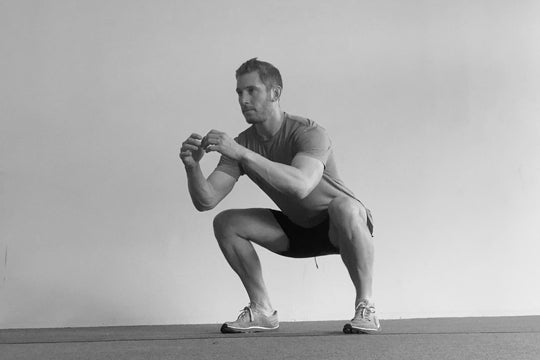Written and demonstrated by Kyle Long (IG @100milekyle), Sport Performance Coach and Path Projects athlete.
The days of the scrawny runner toeing a start line are gone. Maybe that cranky knee at mile 6 or that chronically tight lower back isn’t a result of needing new shoes (but hey who are we to say don’t buy them anyway!). Maybe the bonk at mile 40 wasn’t due to a lack of training miles, maybe being stuck unable to break through distance or timing plateaus isn’t for a lack of effort. Maybe, just maybe, and more than likely, probably, it’s a result of not being strong enough.

Below is a sample week from a month long strength training block. It’s designed to use nothing but a few bands, dumbbells and a pull up bar to allow athletes to train at home or in a gym. This is intended to give you a framework to build a program off of specific to your needs.
WEEK 1, WORKOUT 1
- Workouts should be done 2-3x a week, 30-45 minutes each
- 3-4 sets of each exercise/circuit
- 12-20 repetitions of each exercise
- Allow 36-48hrs after a heavier strength session before long runs or hard interval workouts
- Warm up as needed before each session
15 goblet squats - 4 rounds
15 bodyweight squats - 4 rounds
10 push ups - 4 rounds
10 Hollow Body Rocks - 4 rounds
15 Toe Elevated Dumbbell Romanian Deadlift - 4 rounds
10 Lateral Band Walks (2x per direction) - 4 rounds
15 Bench Dips - 4 rounds
15 Laying Leg Raises - 4 rounds
1 minute wall sit - 3 rounds
1 minute Plank - 3 rounds
1 minute Plank - 3 rounds
WEEK 1, WORKOUT 2
10 Rear Elevated Split Squats (per leg) - 3 rounds
10 Single Leg Romanian Deadlift (per leg) - 3 rounds
6-8 Pull-Ups (use bands if needed) - 3 rounds
12 dumbbell lunges (per leg) - 5 rounds
10 broad jumps (focus on gentle landings) - 5 rounds
6-8 chin ups (use bands if needed) - 5 rounds
30s Copenhagen plank (per side) - 3 rounds
1 minute Flutter Kicks - 3 rounds
30s Russian twists - 3 rounds
Videos: @Celiaruns, Gym: @Convergencept
Training Exercises For Runners
This article intends to help clear the fog around strength training for the endurance athlete and provide a base structure for a program that will set you up to perform better, stay injury free and increase the longevity of your running career, regardless of ability level.
As a runner, the bulk of your training is obviously going to be spent chasing down miles in various capacities. Strength training should be used as an accessory, although vital, part of your overall training program. The goal of a strength program for a runner is to address the common points of weakness, injury and imbalance while improving, not hindering performance during training miles.
When approaching a strength training program, it’s important to address the entire runner. Your first instinct might be to train legs and core and call it a day, but think deeper. What’s largely responsible for maintaining your posture deep into a run? Your back. What supports the load in a pack every step you take? Your traps. What helps catch you on a fall preventing catastrophic injury? Your chest and triceps. Thus it becomes clear, a strength program for a runner should reflect the real world needs of a runner. Here’s how we do that.
First we train dynamically.
This means using a combination of unilateral (single side) and bilateral (both sides) movements. A lunge is an example of a unilateral movement, a back squat is an example of a bilateral movement. Both are equally important, whether it’s in the lower or upper body. Additionally, we train in a variety of planes and speeds. Exercises involving rotation or lateral movement help prevent injuries while running on unstable ground. We often think about training acceleration when in the gym to get faster, but working on deceleration helps stay strong on the long downhills and avoid those cranky knees. All this to say, your strength program should be varied, intentional and designed to bullet proof your body while improving performance.
Second, we train at appropriate intensity and with correct volume.
After the initial “woah this is different” phase of 1-2 weeks, you shouldn’t ever hobble out of a strength session. The ultimate goal is to build stability, strength and power over time while not impacting run performance, so this is a slow, long building process.
Lastly, a program should feature progression.
Repeating workouts in the gym without a change in intensity, load, volume or exercises will result in the same thing as plodding around a track every day for years at the exact same pace; you’ll make some gains up front, and then stagnate and not see further progress. Typically strength training blocks are built in 4,6 or 8 week cycles, and offer a variety of movements, rep schemes and intensities, while generally progressing in an upward direction.
At the end of a training block...
it’s good to have some form of a testing protocol, as well as a recovery week, before starting a new block. This allows us to gauge performance increases and allow the body to regroup and reset, before continuing to build.
Keep an eye open for our upcoming strength training updates, specifically for runners, created by PATH Athlete and Sport Performance Coach Kyle Long (IG @100milekyle).
Other articles by Kyle Long:
- MOUNTAIN LION ENCOUNTERS AT THE WONDERLAND TRAIL AROUND MT. RAINIER
- THE WHY OF RUNNING - SUFFER BETTER
- RUNNING VOLCANIC PEAKS WITH KYLE LONG
- KYLE LONG, BEND OREGON, PATH PROJECTS KREW PAGE
Favorite Path Projects gear Kyle Long Wears:






